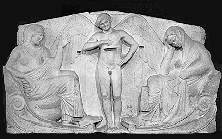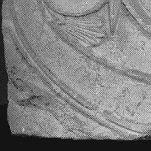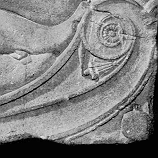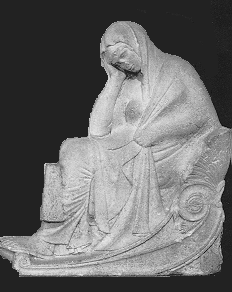| It is very hard to identify the two female figures on the front of the Boston Throne. In traditional representations of Psychostasia, the heroes mothers, Thetis and Eos, sometimes watched over the fate of their sons Achilles and Memnon. However, the two women on the front of the Boston Throne do not relate stylistically to these figures. |
 |
 |
Underneath the Volutes on both sides of the throne are objects which could be attributes of the females. On the left there is a (damaged) fish, identified as a red mullet (indigeneous to the mediterranean, but a favoured dish in Roman times, perhaps linking the Boston Throne to a Roman Workshop?) On the right there is a pomegranate. |  |
| The fish could be linked to the sea, and so to Aphrodite. |
The pomegranate in Greek art is always linked to the goddess Persephone |
| The fish also appears under the old spinning woman on the side panel of the throne. This could suggest the female spinner is the Morai (fate) Klotho, who is a spinner, and linked to the birth of Aphrodite. | The pomegranate also appears under the young lyre player on the side panel of the throne. This could indicate that the lyre player is Orpheus, who is linked to the Underworld and so Persephone. |
| If this were the case, there is no known myth which incorporates all these elements into one scene. The use of Aphrodite and Persephone would link the Boston Throne to the Ludovisi Throne and the cults of Locri Epizefiri, but in doing so the problematic nature of the scene should not be ignored. |
| These associations lead to many theories as to what the relief on the Boston throne actually means. |
 |
Stylistically, the grieving figure, which is perhaps Persephone, has links with the representation of Penelope in her posture and movement. She is very like a Roman copy of a statue called Penelope in the Vatican Museum, right. |  |
 Click to see a larger image |
Interestingly, the grieving figure is also very similar to Penelope as on an attic red figure skyphos, left, of 440BC. This skyphos was first published in a book by W. Helbig in 1871. He allegedly "discovered" the throne in 1894. |